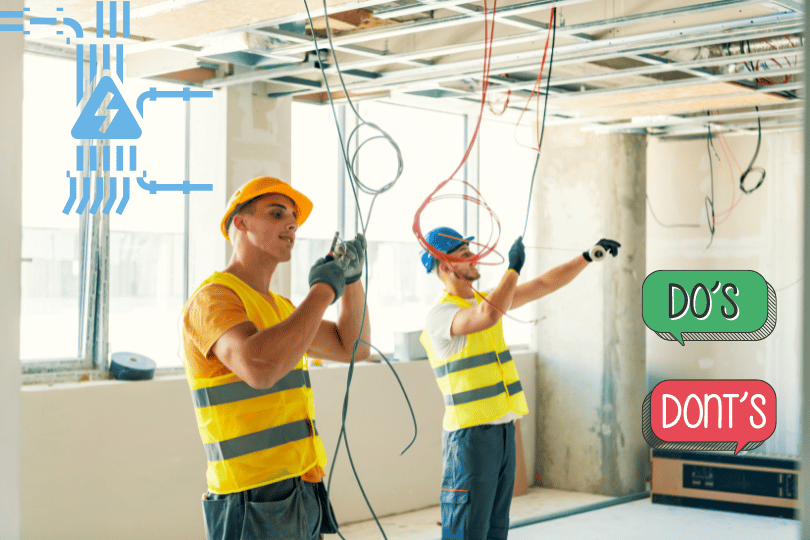Home electrical wiring best practices: Dos and Don’ts
Home electrical wiring is a critical aspect of any household, directly impacting the safety and functionality of appliances and systems. Whether you’re building a new house or renovating an existing one, understanding the dos and don’ts of house electrical wiring is essential to ensure the well-being of your household.

Dos
- Hire a licensed electrician: Hiring a licensed electrician is the first and foremost step in ensuring a safe electrical wiring system. Professionals have the knowledge and expertise to navigate local building codes, ensuring that your home’s wiring meets all safety standards. Electrical work can be dangerous if not done correctly. Unless you have proper knowledge and experience, it’s best to hire a professional electrician for any electrical work.
- Use proper wiring materials: Invest in high-quality wiring materials that comply with safety standards; always make sure the materials are certified as per country specific requirements. Always choose the appropriate wire gauge for the intended purpose to prevent overheating and potential fire hazards.
- Implementation of Safety Devices: Incorporate safety devices such as circuit breakers, Residual Current Circuit Breaker (RCCB), and Miniature Circuit Breaker (MCB) in your electrical system. These devices protect the system from overload and short circuits, enhancing overall safety.
- Use of subcircuits and breakers: Employ subcircuits and breakers in your setup. They not only provide an additional layer of protection against electrical faults, but also aid in pinpointing the location of a fault. This can significantly reduce downtime during maintenance and repair.
- Label electrical panels: Clearly label circuit breakers in the electrical panel to facilitate easy identification in case of a power outage or when making repairs. This will save time and ensure a safer working environment for both homeowners and electricians.
- Secure wiring in conduits: Protect wiring by installing conduits, especially in areas where the wires are exposed or vulnerable to physical damage. Conduits not only safeguard the wiring but also enhance the overall aesthetics of your home.
- Plan adequate outlets: Ensure that your home has an ample number of outlets in each room to avoid the need for excessive use of extension cords. Strategically plan the placement of outlets to accommodate the needs of modern electrical devices and prevent overloading.
- Install GFCI outlets in wet areas: Ground Fault Circuit Interrupter (GFCI) outlets should be installed in areas where water and electricity could potentially mix, such as bathrooms, kitchens, and outdoor areas. These outlets can quickly cut off power if a ground fault is detected.
- Adherence to local standards: Always follow the wiring color code, and wiring practices as per local standards during electrical installations. This ensures safety and facilitates future troubleshooting.
- Use of ferrules: It is recommended to add ferrules at the end of each wire. Ferrules provide clear identification, simplifying future wiring inspections and modifications.
- Keep a wiring diagram: Keep a comprehensive wiring diagram and strictly adhere to it during installations and future modifications. This diagram serves as a roadmap for your electrical system, helps in planning, expansion, troubleshooting and maintenance in the future.
- Regular inspections: Conduct routine inspections of your electrical system to identify potential issues before they escalate. Look for signs of wear, frayed wires, or any anomalies in the electrical panel. Addressing problems promptly can prevent electrical failures and reduce the risk of fires.
Don’ts
- Don’t Overload Circuits: Overloading a circuit can lead to overheating and potentially a fire. This can lead to overheating and increase the risk of electrical fires. Use power strips judiciously and distribute the load across multiple outlets.
- Don’t Use Damaged Wires: Damaged wires can expose the conductive material, leading to potential electrical shocks or fires. Always replace damaged wires immediately.
- DIY electrical work without expertise: Resist the temptation to undertake electrical work without proper knowledge and expertise. DIY electrical projects can result in hazardous conditions, risking both personal safety and the integrity of your home’s electrical system. Always hire a licensed professional for electrical installations and repairs.
- Ignoring local building codes: Familiarize yourself with and adhere to local building codes and regulations. Ignoring these guidelines can lead to substandard wiring practices that compromise the safety of your home. Seek professional advice to ensure compliance with all applicable codes.
- Neglecting grounding: Ensure that all outlets and appliances are properly grounded. Neglecting grounding increases the risk of electrical shocks and may cause damage to sensitive electronic devices. Consult with an electrician if you encounter any issues with grounding.
- Using outdated wiring practices: Avoid using outdated wiring practices that may not meet current safety standards. Keep abreast of technological advancements and adhere to the latest guidelines to ensure the longevity and safety of your home’s electrical system.
Indeed, these are just a few key points to consider when dealing with electrical installations. The field is vast and complex, with many more aspects to explore and understand. Remember, when in doubt, always consult with a licensed electrician to guarantee the highest level of safety and compliance. Use these dos and don’ts for reference and better understanding about house wiring, which helps you to ensure your home’s electrical system is safe and efficient.